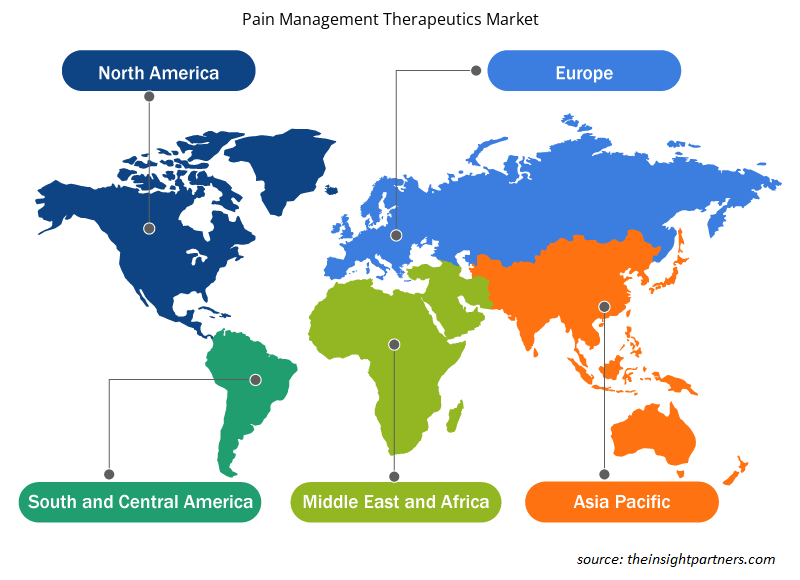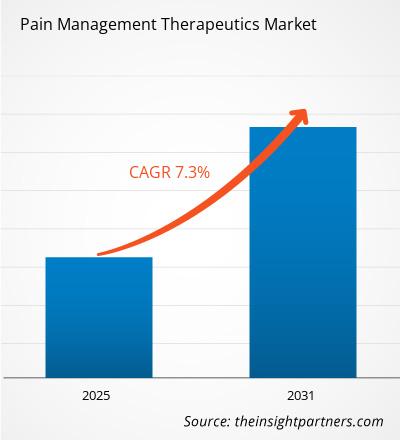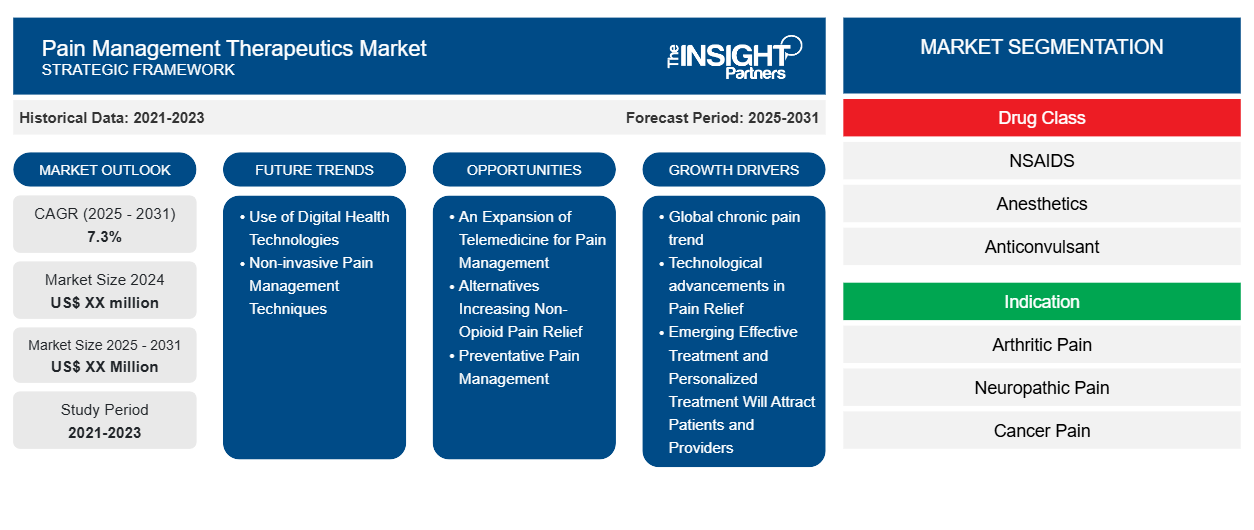疼痛管理治疗市场预计在 2023 年至 2031 年期间的复合年增长率为 7.3%,市场规模将从 2023 年的 XX 百万美元扩大到 2031 年的 XX 百万美元。CAGR of 7.3% from 2023 to 2031, with a market size expanding from US$ XX million in 2023 to US$ XX Million by 2031.
报告根据药物类别(NSAIDS、麻醉药、抗惊厥药、抗偏头痛药、抗抑郁药、阿片类药物等)、适应症(关节炎痛、神经性疼痛、癌痛、慢性疼痛、术后疼痛、偏头痛、纤维肌痛、骨折等)、分销渠道(医院药房、零售药房和网上药房)进行了分析。全球分析进一步细分为区域和主要国家。范围涵盖所有关键细分市场的全球、区域和国家层面的市场规模和预测。报告以美元提供上述分析和细分市场的价值。报告提供了主要市场参与者的市场状况关键统计数据,并提供了市场趋势和机会。
报告目的
The Insight Partners 撰写的《疼痛管理治疗市场》报告旨在描述当前形势和未来增长、主要驱动因素、挑战和机遇。这将为各种业务利益相关者提供见解,例如:
- 技术提供商/制造商:了解不断变化的市场动态并了解潜在的增长机会,从而能够做出明智的战略决策。
- 投资者:对市场增长率、市场财务预测以及整个价值链中存在的机会进行全面的趋势分析。
- 监管机构:监管市场政策和警察活动,旨在最大限度地减少滥用行为,维护投资者的信任和信心,维护市场的完整性和稳定性。
疼痛管理治疗市场细分
药物类别
- 非甾体抗炎药
- 麻醉药
- 抗惊厥药
- 抗偏头痛药物
- 抗抑郁药物
- 阿片类药物
- 其他的
指征
- 关节炎疼痛
- 神经性疼痛
- 癌症疼痛
- 慢性疼痛
- 术后疼痛
- 偏头痛
- 纤维肌痛
- 骨折及其他
分销渠道
- 医院药房
- 零售药店和网上药店
地理
- 北美
- 欧洲
- 亚太
- 南美洲和中美洲
- 中东和非洲
地理
- 北美
- 欧洲
- 亚太
- 南美洲和中美洲
- 中东和非洲
定制此报告以满足您的需求
您可以免费定制任何报告,包括本报告的部分内容、国家级分析、Excel 数据包,以及为初创企业和大学提供优惠和折扣
- 获取此报告的关键市场趋势。这个免费样品将包括数据分析,从市场趋势到估计和预测。
疼痛管理治疗市场的增长动力
- 全球慢性疼痛趋势:慢性疼痛(如关节炎以及其他类型的背痛或神经性疼痛)已成为疼痛管理最重要的市场驱动因素之一。全球老龄人口的增加以及生活方式疾病的增加使得越来越多的人寻求最佳的止痛方法。这种日益增长的需求为疼痛管理领域的先进疗法和产品的开发提供了良好的空间。
- 缓解疼痛的技术进步:其他非常新的技术正在出现,包括神经调节装置、经皮神经电刺激 (TENS) 和激光疗法等创新设备,从而扩大了疼痛管理的治疗选择。与药物相比,这种创新技术将提供非侵入性和针对性的缓解,副作用更小。
- 新兴的有效治疗和个性化治疗将吸引患者和提供者:随着市场不断增长、效率提高和个性化治疗,患者和提供者都将被吸引。从阿片类药物过渡到非阿片类药物以解决阿片类药物危机。阿片类药物危机促使全世界寻求缓解疼痛的替代方法。更重要的是,成瘾和其他滥用情况的日益普遍加剧了患者和医疗保健从业者的焦虑:心理治疗、认知行为疗法等。没有任何成瘾替代品,如针灸或局部止痛药,为患者提供更全面、无阿片类药物的方法,以及为医疗专业人员提供安全、更可持续的实践途径,已经取得了巨大的增长。
疼痛管理治疗市场未来趋势
- 数字健康技术的使用:可穿戴设备和移动应用程序等数字健康工具正在改变疼痛管理的面貌,主要是在使用方面。设备和智能手机应用程序的使用使患者能够在服药期间或在服药后分析此类测量结果期间跟踪疼痛强度,从而为医疗保健提供者提供参考。它将提高患者对护理的参与度、对治疗的依从性以及数字疼痛管理的市场规模。
- 非侵入性疼痛管理技术:目前,微创方法已纳入疼痛管理市场,包括射频消融、硬膜外类固醇注射和外周神经刺激器。这些干预措施旨在减轻疼痛,与传统手术技术相比,受伤几率更小、恢复期更短、副作用更少。因此,随着越来越多的患者寻求此类先进治疗,对疼痛管理微创解决方案的需求将会增加。
疼痛管理治疗市场机会
- 远程医疗在疼痛管理中的应用扩展:远程医疗为疼痛管理开辟了切入点,包括远程疼痛咨询和虚拟疼痛监测。患者可以通过家中互动联系到疼痛专家,从而让农村或医疗资源匮乏地区的患者更容易接受治疗。虚拟康复和远程慢性疼痛管理可以降低医疗成本、改善临床疗效,并增加对数字化疼痛管理解决方案的需求。
- 替代品增加非阿片类止痛药:鉴于危机加剧了对更安全选择的需求,开发非阿片类替代品来应对这种情况是一个巨大的机会。基于 CBD、局部止痛药以及生物疗法的产品正在蓬勃发展。投资此类替代品的公司将有望占领快速增长的市场,这些市场包括寻求替代方法来缓解疼痛而又不冒阿片类药物相关风险的患者。
- 预防性疼痛管理:由于人们意识到慢性疼痛的状况,对慢性疼痛预防的需求不断增加:生活方式改变计划,加上物理治疗和早期干预,越来越受欢迎;因此,为公司提供综合解决方案的机会是开放的,可以防止疼痛的发生并减少治疗时间。
疼痛管理治疗市场区域洞察
Insight Partners 的分析师已详尽解释了预测期内影响疼痛管理治疗市场的区域趋势和因素。本节还讨论了北美、欧洲、亚太地区、中东和非洲以及南美和中美洲的疼痛管理治疗市场细分和地理位置。

- 获取疼痛管理治疗市场的区域特定数据
疼痛管理治疗市场报告范围
| 报告属性 | 细节 |
|---|---|
| 2023 年的市场规模 | XX 百万美元 |
| 2031 年市场规模 | XX 百万美元 |
| 全球复合年增长率(2023 - 2031) | 7.3% |
| 史料 | 2021-2022 |
| 预测期 | 2024-2031 |
| 涵盖的领域 | 按药物类别
|
| 覆盖地区和国家 | 北美
|
| 市场领导者和主要公司简介 |
|
疼痛管理治疗市场参与者密度:了解其对业务动态的影响
疼痛管理治疗市场正在快速增长,这得益于终端用户需求的不断增长,而这些需求又源于消费者偏好的不断变化、技术进步以及对产品优势的认识不断提高等因素。随着需求的增加,企业正在扩大其产品范围,进行创新以满足消费者的需求,并利用新兴趋势,从而进一步推动市场增长。
市场参与者密度是指在特定市场或行业内运营的企业或公司的分布情况。它表明在给定市场空间中,相对于其规模或总市场价值,有多少竞争对手(市场参与者)存在。
在疼痛管理治疗市场运营的主要公司有:
- 诺华公司
- 礼来公司
- 雅培实验室
- ENDO 健康解决方案公司
- 普渡制药
免责声明:上面列出的公司没有按照任何特定顺序排列。

- 了解疼痛管理治疗市场顶级关键参与者概况
主要卖点
- 全面覆盖:该报告全面涵盖了疼痛管理治疗市场的产品、服务、类型和最终用户的分析,提供了整体概况。
- 专家分析:报告基于对行业专家和分析师的深入了解而编写。
- 最新信息:该报告涵盖了最新信息和数据趋势,确保了其与业务的相关性。
- 定制选项:此报告可以定制以满足特定客户要求并恰当地适应业务策略。
因此,疼痛管理治疗市场研究报告有助于引领解读和了解行业情景和增长前景。尽管可能存在一些合理的担忧,但本报告的总体优势往往大于劣势。
- 历史分析(2 年)、基准年、预测(7 年)及复合年增长率
- PEST和SWOT分析
- 市场规模、价值/数量 - 全球、区域、国家
- 行业和竞争格局
- Excel 数据集
近期报告
相关报告
客户评价
购买理由
- 明智的决策
- 了解市场动态
- 竞争分析
- 客户洞察
- 市场预测
- 风险规避
- 战略规划
- 投资论证
- 识别新兴市场
- 优化营销策略
- 提升运营效率
- 顺应监管趋势





















 获取免费样品 - 疼痛管理治疗市场
获取免费样品 - 疼痛管理治疗市场